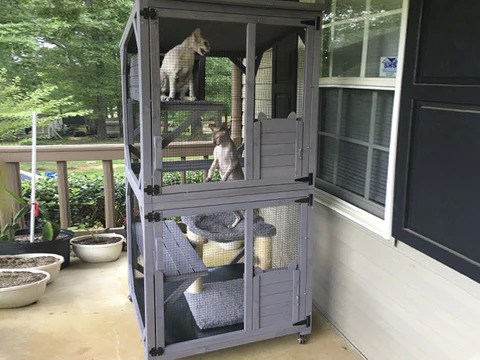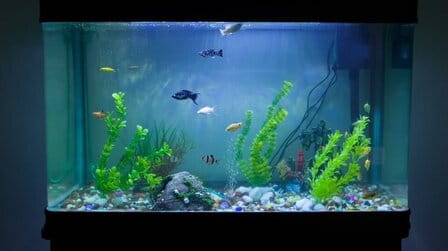Conceptualizing and designing a small, warm home can save a feral cat's life during the winter. You can make it from a plastic box or scrap wood. However, for those who do it for the first time, it will be a bit confusing as to how to build a house for cats. So, to make it easier, let's learn the steps to make a cat house.
1. Outdoor cat house
1.1 Find building materials
Outdoor cat material needs shelter from weather conditions. Use sturdy construction materials or reuse existing containers. As a plastic tank (about 35 gallons / 132 L)
Reuse an old barn from a friend or neighbor
Plywood or lumber (a 4 x 8 ft board, or scrap)
1.2 Dimensions
A cat's body temperature can only warm a small space. The highest dimensions are about 26" x 26" x 32" (66 x 66 x 81 cm.) If you are using an existing container significantly larger than this size, split it or divide it with planks. squeeze.
These dog home guidelines will also work for cats, with modifications described below. Use these if you are building a house from lumber or plywood.
1.3 Making the roof removable
The removable roof makes it easy to change dirty bedding and check for an animal that's injured if it wanders into the house. If you are building your own house, it is advisable to attach the roof to the wall with hinges. Therefore, when using a plastic tank, use the lid as a cover. Once completed, you can use rocks or other heavy objects to press down on the roof.
1.4 Raise the house off the ground
The shelter must be raised if you think there is snowfall or flooding in the area. 18 inches (46 cm) is sufficient for most areas, but 12" (30 cm) or less will be appropriate in areas with less severe weather.
Keep shelter in a tall, sheltered yard.
Place shelters on piles of wood chips, concrete blocks, or other objects. The stack must be completely flat and firm. Arround it with heavy objects if necessary to prevent collapse.
Hold it on a sturdy plywood board raised off the ground by four 2x4 (38 x 89mm) legs attached with covered deck screws.
1.5 Creating entrances and exits
Cats prefer shelters that have two entrances so they can escape from predators sniffing at one entrance. Cutting two 6 x 6" (15 x 15 cm) doorways on different sides. If using plastic, cover sharp edges with tape.
If the house is not raised, start cutting the doorway about 2 inches (5 cm) off the ground to prevent rainwater from entering.
If the house is raised, cut the entrance on one side with a front ledge (from plywood or a stacked object) so the cat can jump on it. Cut the exit somewhere with no ledge underneath so predators can't easily reach it.
For extra warmth, pin fabric or tarp tarps on the inside of each doorway.
1.6 Roof waterproofing
The plastic tank is already waterproof, so you can skip this step. If using plywood or lumber, or a dog house, sand and paint it to protect it from rain.
For serious protection and further insulation, cover the roof with roofing material.
A cat house can be warm enough without this step, but any other material needs insulation. Line each wall by gluing 1" (2.5 cm) thick foam insulation from a home improvement store. Put a 3" (7.5 cm) gap at the top of the wall. Put a piece of foam on the wall to insulate the roof.
In areas with severe winters, consider using Mylar instead, which will reflect your cat's body temperature. You can also line the floor with Mylar. Cut foam with a utility knife.
1.7 Fill the house with burrowing materials
Place plenty of straw, without blocking the doorways, so the cat can get in for extra warmth. If you don't have a straw, you can use pillowcases stuffed with packing peanuts or shredded newspaper.
Do not use hay as they are hygroscopic and can cause allergies.
Do not use blankets, towels, or loose newspapers. These can absorb body heat and cool the cat's body.
Some cats will eat packaged peanuts, which can cause an intestinal blockage. Double-wrap them with pillowcases to minimize this risk.
1.8 Provision of food and water
Keep food inside the shelter, but water should be left outside to prevent spills. Keep a water dish nearby
In temperatures below freezing, use an electric hot water dish. If you can't afford one, use a thick ceramic or plastic saucer and surround it with foam.
1.9 Attract cats with catnip
Invite feral cats into the shelter with some catnip right inside the entrance.
2. Indoor cat house
2.1 Find cardboard boxes
Cardboard boxes or foam boxes will make a house especially easy. You can make your box out of corrugated cardboard, poster board, or any other lightweight material, but an existing box will be sturdier. If the box is smaller than 2 x 3 feet (60 x 90 cm), many boxes will be needed to make the house large enough. Cats can usually chew on cardboard or foam, so please reuse them.
2.2 Cut a few doors
Usingknife to cut through one of the cardboard boxes. Each doorway should be 6 inches (15 cm) high to fit the cat comfortably.
Cut a few small windows or observation strips if you want to watch the cat as it plays inside.
Stick excess rags or clothes on doors and windows so that your cat can spend some alone time.
2.3 Tape on the additional box
You should add room numbers to the cat house using additional boxes. To make the second floor, cut a 6-inch (15 cm) hole in the ceiling and glue another box upside down on it. The floor should be wide enough for the cat to walk.
Use packing tape, duct tape, or other strong adhesive tapes.
2.4 Warm up the cat's living space
Adding a small blanket or a cat bed inside. A scratch post or rough towel gives your cat something to scratch. If you have a multi-story cat house, put a super fun toy on the top floor for the cat to happily find a way to reach.
2.5 Place food, water, and garbage outside the home
Keeping food and water in the house often leads to a mess, even to the collapse of cardboard. From there, you can move them closer, but show your cat their new location to make sure they don't return to their old bath.
How to choose a cat house
1. Main design of the house
If the design is different in the house designed exterior and interior. However, if you understand the simple design with lightweight or a more practical design, it will not be easy to move.
If it is the interior, the cat's house must completely match the design of the house, so as not to get tired of having an element that does not match anything in the house.
If you're looking for something bigger, you'll find houses up to two meters high, with terraces and stairs. Yes, cats also love to live in luxury homes.
2. Crafting materials
The cat's house material will be created to adapt it to the space in which it will be placed. This way, your cat can avoid pet risks.
For the interior, materials such as fabric and plastic are often used, which are easy to clean and transport. For exteriors, people often look for materials such as different types of wood or corporations that have a special gloss finish to prevent degradation due to climate change.
3. Measurements and dimensions
Although the cat does not have much difference in size, it is necessary to verify their measurements to avoid inconvenience later.
Mostly, pre-designed homes are suitable for small and even medium-sized cats. For big cats, be sure to measure its measurements in detail, so as not to have to buy a house with little free space. At this point, your pet should be able to lie comfortably and rest without mobility problems in his or her own home.
4. Craft cat house
You can also make your own cat house. If it feels right, several materials can be used for it.
4.1 With recycled materials

For cardboard houses for cats. With thin cardboard and laminated paper, you can build a beautiful home for your kitten. You just need to take the measurements and can make it the way you like best.
4.2 Wooden cat house
You can collect excess wood chips and shape the house you want to join, with nails and a little creativity.
4.3 Houses made of cloth

If there is any excess fabric that is quite large or if you want to buy a special fabric, it is possible to make a cat house in the shape of an Indian shop. Make sure that the sticks used are firmly fixed to the ground.
5. Indoor or outdoor cat house

There are different types of cat homes, either indoors or outside of your home. You also need to choose how you want the interior of the house. There are some with mattresses, others with pillows or cushions, and others with special cushions for each type of cat, among others.
6. Make your cat cozy
After choosing the material, the next thing you need to do is create a cozy home. You can add objects or toys that make the cat feel comfortable, especially when the house is new so that the cat won't be reluctant to step in and make it her own space.
On the other hand, you can choose to buy a cat house directly with everything you need, if you have free time and feel like it, you can make it yourself.
Conclusion
Through the information we have mentioned above, we are happy to provide you with the steps to choose a home and build a home using recycled and available materials or not. In addition, we also share ways to help cats stay in the best shape when in the house. The article on how to build a house for cats will be the best sharing for you.













